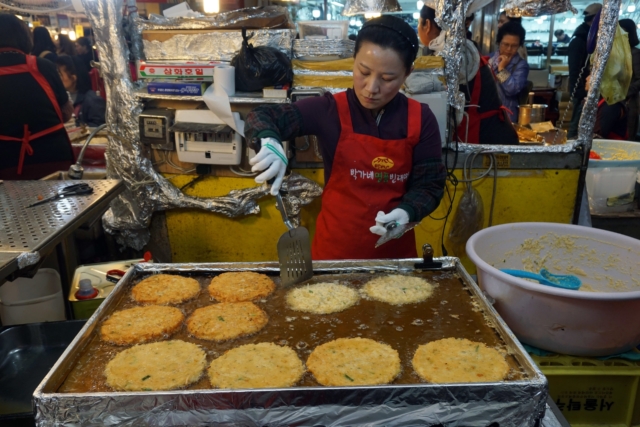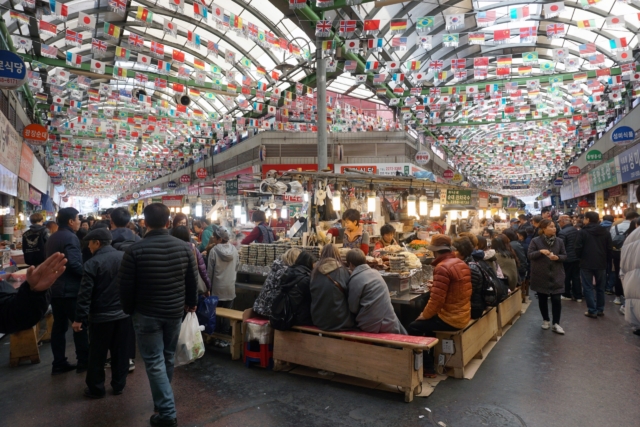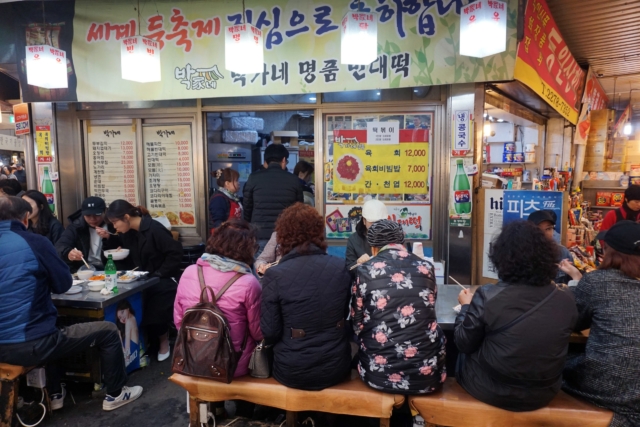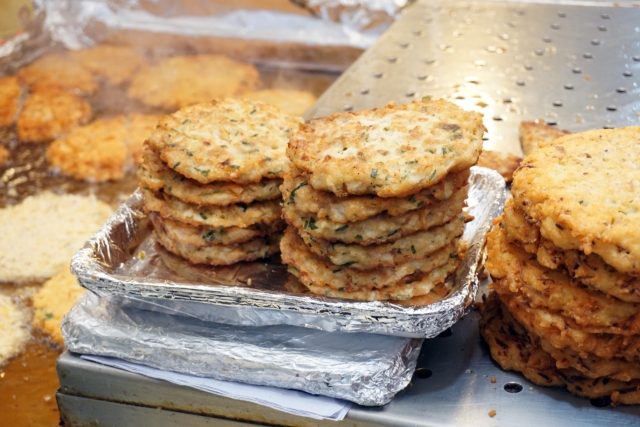Bindaetteok pancakes at Seoul’s Gwangjang Market, coupled with Korean rice wine makgeolli, are a gorgeous treat that will become one of your Proustian madeleine moments.
There is shuffling and laughter as a tall man swerves to the right to let a woman and her child pass. A woman, red bandana holding her hair, thrusts mung beans into a large, sturdy stone grinder with a smacking sound, before rotating it to turn the now yellow-ish beans into a smooth paste.
On the other side of the pillar, another woman wipes her forehead with the back of one hand, and with the other flips pancakes sizzling in a sea of oil. Some are topped with slithers of meat. The tall man makes his order, two plain bindaetteok, two with meat and one bottle of makgeolli. He waves to his colleagues to follow him and find a seat.
They are about to enjoy mung bean pancakes, bindaetteok in Korean, a thick load full of nutty, earthy flavours. Aside from ground mung beans, the pancake mixture can include kimchi, ground pork, onions, sprouts, and glutinous rice.
Bakgane Bindaetteok at Gwangjang Market
That day, my friend and I crossed paths with the tall man and his colleagues, and with many other people who had flocked to Gwangjang Market for sinful treats. We scanned the place with our eagle eyes and went on full throttle forward as soon as we spotted a free space.
The stand is conveniently located at the center of the buzzing market’s main intersection and it’s not always easy to find a seat. The nutty aromas wafting through the air, coupled with the frizzle of brown, chunky pancakes is enough to stop anyone in their tracks. Diners sit on wooden benches surrounding the booth, or in the small two-storey restaurant in the adjacent building.
We settled down at our blue plastic table, poured makgeolli into each other’s gold-coloured aluminum cups while receiving the drink with both hands – a symbol of respect. One jjan (cheers) and a barely containable build-up of excitement later, we got started on the bindaetteok. My friend tore the large, thick pancake into pieces before grabbing one and dipping it into a spicy soy-based sauce. The freshly deep-fried bindaetteok, moist and drunk with flavour, crispy from the outside, were enough to experience a momentary fade-out of all outside sounds and smells. Daebak, as Koreans would say. We had hit the jackpot.
Understanding bindaetteok
Mung beans, which are cultivated mainly in East Asia, Southeast Asia and the Indian subcontinent, are used in both savoury and sweet dishes. They can range from Indian dal to Hong Kong ice cream to Chinese mooncakes and Filipino ginisáng monggó, a sautéed mung bean stew.
The first recorded mention of bindaetteok, the mung bean pancake we know and love today, comes from a Korean cookbook called Eumshik Dimibang, written around 1670. That time, it was called binjatteok, literally a pancake for poor people. Binja became bindae, which means distinguished guests.
It was a time when bindaetteok was an indicator of class by the toppings that were used: chunks of pork for the wealthy, plainer varieties for the lower social classes. On occasion, such as at a ceremonial altar, the bindaetteok was shared by both. It was the host of the house who would eat the meat on top, and the poor, or those who did the chores on the banquet day, who would eat the plain pancake only.
Crash Landing on You fans rejoice, while the hearty pancake can be found in many food markets in Seoul today, it originates from Pyongan Province in the northwest of North Korea. Ground, soaked mung beans combine with vegetables and/or meat to make a batter that is pan-fried into a round, thick pancake.
Bindaetteok is also one of many occasion foods that exist in Korea today. Although jeon with makgeolli is the typical combo to have on a rainy day, bindaetteok as another type of pancake is a popular alternative. The sound of frying a pancake in oil and rain drops hitting the ground – I immediately understood the connection.
Bindaetteok is enough to fill you up, but Gwangjang Market has many other mouth-watering dishes waiting to be devoured (or enjoyed more slowly with some soju shots).
Info
Area: Gwangjang Market, Seoul, South Korea
Closest subway station: Jongo 5-ga (line 1)
Address: Gwangjang Market, 88 Changgyeonggung-ro, Jongno 4(sa)-ga, Jongno-gu, Seoul, South Korea
Opening times: Daily 9am – 5pm
Website: http://www.kwangjangmarket.co.kr/
Recipe
Maangchi’s recipes are clear, easy to follow and end with a mouth-watering dish on your plate. Her bindaetteok recipe is no different.







